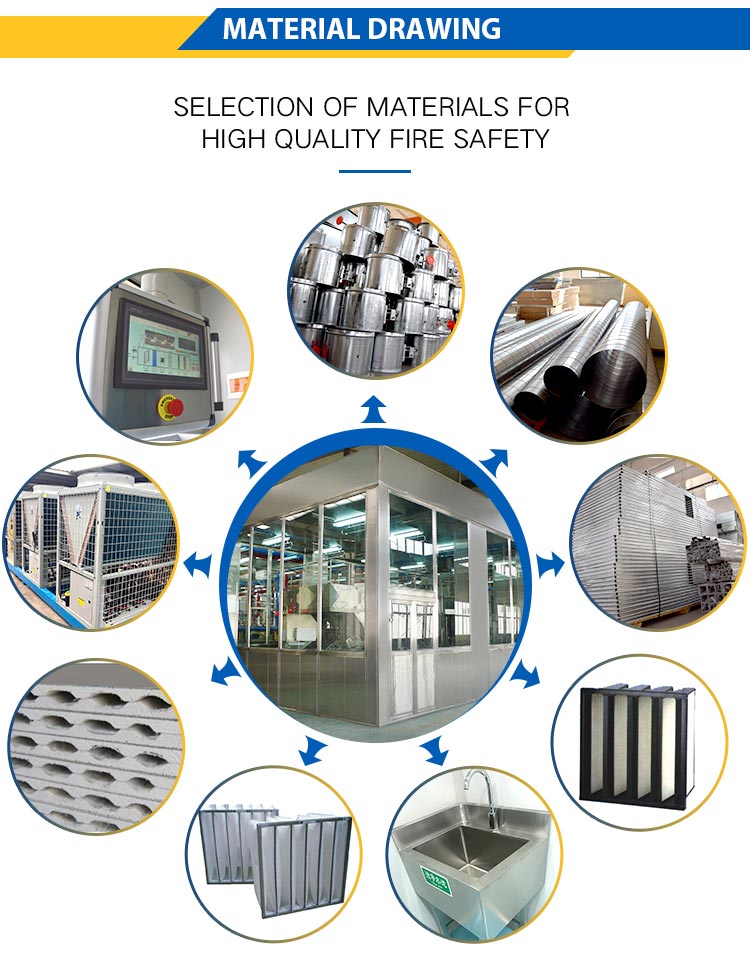Classification of clean rooms
(1) According to the airflow flow pattern, clean rooms can be divided into unidirectional flow clean rooms; Non-unidirectional flow clean room; Mixed flow clean room; Vector stream clean room.
1. One-way flow clean room
Unidirectional flow (laminar flow) clean room, which is divided into vertical unidirectional flow clean room and horizontal unidirectional flow clean room.
FIG. 1 Flow pattern of unidirectional flow
The purification principle of one-way flow is piston and extrusion principle, the dust is extruded from one end to the other end, and the polluted air is replaced with clean air flow. Including vertical unidirectional flow and horizontal unidirectional flow.
The vertical unidirectional flow is the airflow flow pattern from the ceiling to the floor at a certain speed (0.25m/s~0.5m/s). This air flow can create levels 100, 10, 1 or higher. But its initial investment is very high, the operation cost is very high, the project as far as possible to compress its area to the minimum, use must use parts.
Horizontal unidirectional flow is the flow pattern in which the air flows from one wall to the opposite wall at a certain speed (0.3m/s~0.5m/s). This air stream can create 100 levels of purification. Its initial investment and operating cost are lower than those of vertical unidirectional flow.
2. Non-one-way flow clean room
The air flow pattern of the non-unidirectional flow clean room can be divided into top feed and bottom return; Top send down side back; Top to back, etc.
FIG. 2 Flow pattern of non-unidirectional flow
The purification principle of non-unidirectional flow is the dilution principle. The general type is high efficiency filter air supply port top air supply; The type of return air includes lower return air, side lower return air and top return air. According to the different air supply times, to achieve different purification levels, its initial investment and operating costs are also different.
3. Mixed flow clean room
FIG. 3 Mixed flow flow pattern
Mixed flow is an air flow pattern composed of vertical unidirectional flow and non-unidirectional flow. The characteristic of this flow is to compress the vertical unidirectional flow area to the minimum and replace the large area unidirectional flow with large area non-unidirectional flow to save the initial investment and operation cost.
4, vector flow (diagonal flow) clean room
Choose the air flow pattern of the upper circular arc type hePA air outlet and the lower air outlet on the opposite side.
FIG. 4 Vector flow pattern
The air flow in the vector flow clean room is out of the radial streamline. There is no vertical cross between the streamline lines, and a relatively small amount of air supply can be used to obtain a higher level of cleanliness. It is widely used in small clean rooms in pharmaceutical, medical and electronic industries. It is also widely used in some special laboratories.
Air supply volume of clean workshop with different cleanliness levels
Indicators of cooling capacity investment power consumption (for reference only)
Note: Air supply volume and unidirectional flow in the table are expressed by the cross-section wind speed, while non-unidirectional flow is expressed by the number of air changes.
The cooling capacity index in the table generally refers to the electronic industry clean workshop. The initial investment in the table includes the enclosure of clean plant, refrigeration supply system and air conditioning purification system, excluding the investment in civil structure and automatic control. The power consumption in the table refers to the power consumption of refrigeration system and air supply system of air conditioner, excluding the power consumption of electric heating and electric humidification.
(2) According to the main control objects of clean rooms, clean rooms can be divided into: industrial clean rooms; Biological clean room.
1, industrial clean room
The main control object of industrial clean room is dust particles (whether living or inanimate).
Industrial clean room is mainly used in electronics, aerospace, aviation, machinery, chemical, chemical pharmaceutical, energy, nano and other industries. In particular, the electronic and optoelectronic industries are inseparable from clean rooms and clean technology.
2. Biological clean room
Biological clean room is mainly controlled by living and living microbial particles, such as bacteria, viruses and other particles harmful to human beings, animals and the environment.
Biological clean room is widely used in medical treatment (clean operating room, clean ward), biopharmaceutical, experimental animal feeding, biosafety laboratory, health and epidemic prevention and quarantine. The development of biological clean room is very fast, and has been recognized and valued by all parties.
Table of difference between industrial clean room and biological clean room
Three, clean room cleanliness grade standards
Iso-14 ** 4 is an international standard, now the United States, Europe, Japan, Russia and our country are using this standard, the United States originally used is the United States Federal standards 209A, B, C, D, E, now the United States is not.
The previously familiar 100, 1000, 10000 and 100000 levels are derived from the US federal standard FS209B, now they are replaced by the international standard ISO-14 ** 4 levels 5, 6, 7 and 8 respectively.
1, ISO-14 ** 4 cleanliness grade standards are listed as follows
Cleanliness levels of suspended particles in clean rooms and clean air
Note :(1) each point should be sampled at least 3 times.
(2) This Standard does not apply to characterization of the physical, chemical, radiological or vital properties of suspended particles.
(3) 1~2 particle size can be determined according to the process requirements.
(4) According to the maximum allowable concentration of particle size D is determined by the following formula (particle size 0.1μm~5μm).
Where, N refers to the degree of cleanliness between 1 and 9, and 0.1 can be inserted as the minimum unit increment.
2, the national standard of cleanliness grade standard ISO-14 ** 4 and the cleanliness grade standards of various countries are compared as follows